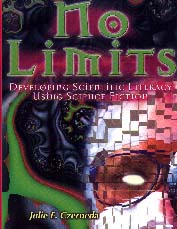|
________________
CM . . . .
Volume VI Number 13 . . . . March 3, 2000
This is a splendid resource book to discuss the interaction between the individual, science,
technology and society [STS], probably for the grade 10 level. The stories are very readable and
imaginative and well annotated to help the teacher discuss the story line and the imbedded
scientific, ethical and moral issues. These stories serve well as contexts that generate questions
about science and technology that interest students and are well beyond the science textbook.
They are also very effective in emphasizing that scientific activity is a human endeavor and,
therefore, fraught with pitfalls and temptations of both the intellectual and ethical variety. The
answer to the question, "What is this thing called science?" can be answered, at least in part by
such stories.
I am less secure, however, about the claim that science fiction [SF] is a good vehicle for
developing scientific literacy [SL]. I agree that "what if" questions may motivate students to
explore science concepts more deeply. But if an operational definition of SL is accepted as the
one shown by the table on page 41, then the science I find in these stories will not be a good
testing ground for the "skills" that are listed. The questionnaire on page 115 may come a little
closer, but it assumes a good background knowledge of science already. The very title, "No
Limits...," contains an unscientific idea. What distinguishes good science from bad science are the
strict limits imposed by a theory or paradigm that allows you to decide "what makes sense and
what does not." The speed of light and the second law of thermodynamics [entropy] are such
limits. Of course, "what if" questions, like, "What would happen if a scientists were able turn off
the electromagnetic field on the atomic level?" [as is the story "Packing Fraction"] are interesting
and, as in this case, requires the discussion of the concept of 'packing fraction' on the atomic
level. But it will contribute significantly to SL only if it leads to a discussion of why
electromagnetic theory imposes those limits. What if extraterrestrial intelligence have found a way
to travel faster than the speed of light or have found an anti-gravity device? These are question
that SF writers ask. Again, whether or not a story that explores these questions will be a good
setting in which we can promote SL depends on the writer's scientific knowledge. The great
physicist Edward Teller argued that "the trouble with SF is that it is too unimaginative." He was
referring to black holes, missing mass, and worm holes, exotic ideas that are within the constraints
of physics but could have never been invented by a SF writer.
I am all for using a book like this one for embellishing the science experiences of students. But let
us not make unreasonable claims that such experiences lead to developing SL in a significant way.
At best we could say that one aspect of SL is the ability to enjoy a well crafted SF story. Arthur
C. Clark once said that "to us the discoveries and the technology of a future society will not be
distinguishable from magic." Whatever this magic would appear to be, it is certain that future
science and technology will have definable limits. SF writing that will significantly contribute to
developing SL will have to be guided by this idea. I will give Albert Einstein the last word: "I just
want to know if the Lord had a choice when he made the world."
Recommended.
Arthur Stinner is a professor of physics education and the history of science in the Faculty of
Education, the University of Manitoba.
To comment on this title or this review, send mail to cm@umanitoba.ca.
Copyright © the Manitoba Library Association.
Reproduction for personal use is permitted only if this copyright notice
is maintained. Any other reproduction is prohibited without
permission.
Published by
TABLE OF CONTENTS FOR THIS ISSUE - March 3, 2000.
AUTHORS |
TITLES |
MEDIA REVIEWS |
PROFILES |
BACK ISSUES |
SEARCH |
CMARCHIVE |
HOME
|
